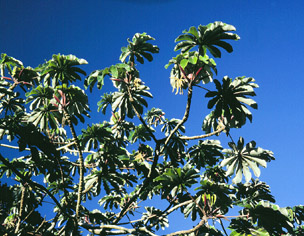|
Cecropia Loefl.
Descriptions -- Digested by bats -- Dispersed by bats -- Notes -- Species treatments -- References Description. Trees of secondary growth, very common in gaps and clearings. Stipules caducous, leave conspicuous scars. Leaves simple, alternate, usually palmately dissected. Infructescences digitate, thick, finger-like spikes arising from uppermost leaf axils, with numerous fruits; peduncle long (10-29 cm) and flexible in C. obtusa and C. palmata, or short and thick in C. sciadophylla. Fruits surrounded by enlarged perianths, achenes, obovoid, oblong, ellipsoid, lanceolate-ellipsoid, 2-3 x 0.8-1.3 mm, light yellow, brown or dark brown, glossy, the surface undulate-rugose or tuberculate; mucilage exudes from exocarp after placed of fruits in water. Pericarp thick, 150-200 µm, with 5-14 layers, differentiated into exocarp, mesocarp, and endocarp, the exocarp a single layer of mucilaginous and non-mucilaginous cells, the mesocarp multilayered, with tanniniferous cells, sclereids, and crystal-bearing cells, the endocarp a single layer of macrosclereids. Seeds oblong-ovoid or obovoid, 1.6-1.9 x 0.5-1.2 mm, light yellow or light brown, glossy, the surface indistinctly striate-reticulate. Seed coat derived from 2 integuments, in mature seed reduced to two-layered membrane 8-11 µm thick. Endosperm present in mature seeds, of 2-6 layers. Embryo linear, straight, with large plano-convex cotyledons. Digested by bats. The thin, fleshy (when fresh), white-greenish perianth, surrounding the fruits is removed by bats. The fruits lose the mucilaginous part of the exocarp while passing through the digestive tract of bats. Dispersed by bats. Although most of the bat/plant literature refers to the diaspores of Cecropia found in the feces of bats as seeds, they are fruits. Notes. The species of Cecropia seem to be a preferred food of species of Artibeus. Cecropia sciadophylla is a species primarily dispersed by birds but occasionally consumed by bats. Fruits of different species of Cecropia can be distinguished by using the following characters: shape, size, color, type of surface, and exocarp and mesocarp structure. Species treatments.
C.
obtusa,
C. palmata, C.
sciadophylla. Berg, C. C. & P. Franco-Roselli. In press. Cecropia. Fl. Neotrop. Mongr. xx: xxx-xxx. Charles-Dominique, P. 1986. Inter-relations between frugivorous vertebrates and pioneer plants: Cecropia, birds and bats in French Guiana. Pages 119-135. In: A. Estrada & T. H. Fleming, editors. Frugivores and Seed Dispersal. Dr. W. Junk Publishes. Dordrecht. Charles-Dominique, P. & H. M. Cooper. 1986. Frugivorie et transport des graines de Cecropia par les chauves-souris en Guyane. Mém. Mus. Natl. Hist. Nat. 132: 145-157. Charles-Dominique, P. 1993. Speciation and coevolution: an intrepretation of frugivory phenomena. Vegetatio 107/108: 75-84. Cockle, A. 1997. Modalités de dissemination et d'etablissement de lianes (Cyclanthaceae) et Philodendron) en forêt Guyanaise. Université de Paris 6, Paris. 406 pp. Cooper, H. M. & P. Charles-Dominique. 1985. A microcomputer data acquisition-telemetry system: a study of activity in the bat. J. Wildl. Manage. 49: 850-854. de Foresta, H., P. Charles-Dominique, C. Erard & M.-F. Prévost. 1984. Zoochorie et premiers stades de la régéneration naturelle après coupe en forêt Guyanaise. Rev. Ecol. (Terre et Vie) 39: 369-400. Gorchov, D. L., F. Cornejo, and C. F.Ascorra. 1995. Dietary overlap between frugivorous birds and bats in the Peruvian Amazon. Oikos 74: 235-250. Lobova T. A., S. A. Mori, F. Blanchard, H. Peckham & P. Charles-Dominique. 2003. Cecropia as a food resource for bats in French Guiana and the significance of fruit structure in seed dispersal and longevity. American J. Bot. 90: 388-403. Reis, N. R., dos, and J.-L. Guillaumet. 1983. Les chauvees-souris frugivores de la région de Manaus et leur rôle dans la dissémination des espèces végétales. Revue d'écologie; la terre et la vie 38: 147-169. Reis, N. R., dos, and A. L. Peracchi. 1987. Quirópteros da região de Manaus, Amazonas, Brasil (Mammalia, Chiroptera). Boletim do Museu Paraense Emilio Goeldi, Série Zoologia 3: 161-182. Zortéa, M. & A. G. Chiarello. 1994. Observations on the big fruit-eating bat, Artibeus lituratus, in an urban reserve of south-east Brazil. Mammalia 58: 665-670. |
